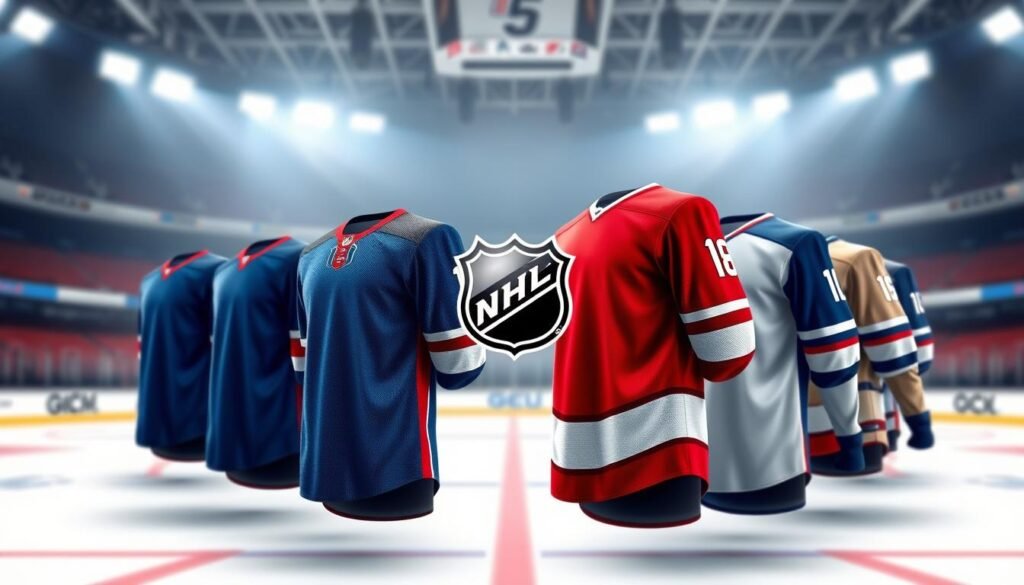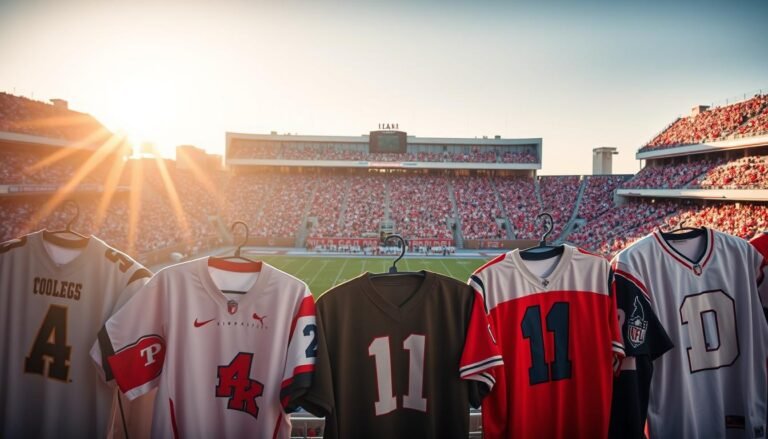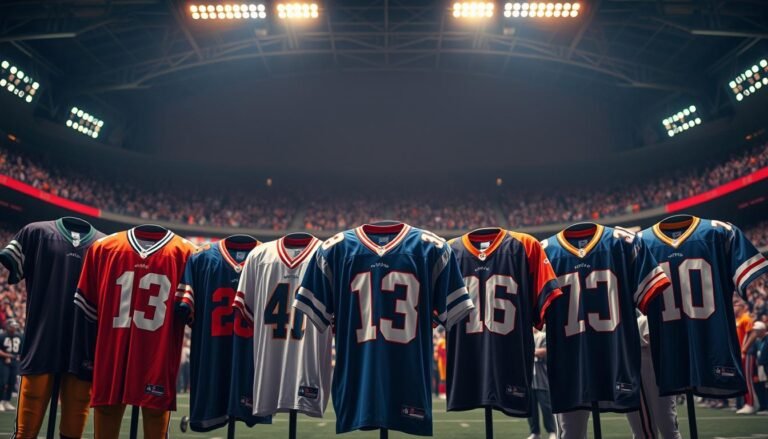The history of hockey jerseys is a fascinating story of innovation and adaptation. Initially, NHL players wore simple wool sweaters, but over the years, these garments have transformed into high-tech performance gear.
The evolution of NHL jerseys reflects broader changes in technology, culture, and the sport itself. Advances in materials and manufacturing have enabled the creation of lighter, more breathable, and more durable jerseys.
Today’s NHL jerseys are designed to enhance player performance while also showcasing team identity and style.
Key Takeaways
- The NHL jersey has undergone significant transformations since its inception.
- Advances in technology have driven the development of modern hockey jerseys.
- Modern jerseys prioritize both performance and style.
- The evolution of NHL jerseys reflects changes in the sport and culture.
- Jersey design now incorporates advanced materials and manufacturing techniques.
The Birth of Hockey Uniforms (1900s-1920s)
As hockey began to take shape in the early 1900s, players wore wool sweaters that would eventually evolve into the sophisticated jerseys we know today. The early days of hockey uniforms were marked by simplicity, with wool sweaters being the primary material. These sweaters were not just rudimentary; they laid the foundation for the modern hockey jersey.
Wool Sweaters and Early Design Elements
The use of wool sweaters in early hockey was practical, given the material’s warmth and availability. However, these early jerseys were far from the high-tech gear we see today. They were basic, often featuring simple designs and minimal protective elements.
- Early hockey jerseys were made from wool, providing warmth but lacking in advanced technology.
- Designs were simple, with an emphasis on team colors and basic crests.
First Team Identities Through Colors and Crests
Team identities in early hockey were established through colors and crests. These visual elements were crucial in distinguishing one team from another. The use of distinct colors and emblems on jerseys helped create a sense of unity and identity among players and fans.
The early 20th century was a formative period for NHL jerseys, with the foundational elements of team identity being laid. As the league evolved, so too did the designs and materials used in hockey uniforms, paving the way for the sophisticated, high-performance jerseys of today.
The Original Six Era (1920s-1967)
The Original Six era, spanning from the 1920s to 1967, was crucial in shaping the visual identities of NHL teams. This period saw significant developments in the standardization of jersey designs, the establishment of iconic team looks, and advancements in materials and construction techniques.
Standardization of Jersey Designs
During the Original Six era, NHL jersey designs became more standardized. Teams began to consistently use specific colors and design elements that would become synonymous with their identities. This standardization helped in creating a sense of tradition and continuity for the teams.
Iconic Looks of the Original Six Teams
The Original Six teams – Boston Bruins, Chicago Black Hawks, Detroit Red Wings, Montreal Canadiens, New York Rangers, and Toronto Maple Leafs – developed some of the most iconic jersey designs in NHL history. For example, the Bruins’ black and gold, the Red Wings’ winged wheel logo, and the Canadiens’ distinctive “C” logo are still revered today.

Materials and Construction Techniques
The materials used for NHL jerseys during the Original Six era were primarily wool sweaters, which were later replaced or complemented by other materials. The construction techniques improved over time, allowing for more durable and comfortable jerseys.
| Team | Primary Colors | Iconic Design Element |
|---|---|---|
| Boston Bruins | Black, Gold | Bruin logo |
| Chicago Black Hawks | Red, Black | Indian head logo |
| Detroit Red Wings | Red, White | Winged wheel logo |
The evolution of NHL jerseys during the Original Six era laid the groundwork for future innovations in design, materials, and manufacturing techniques, contributing to the rich history of NHL uniforms.
Expansion and Innovation (1967-1979)
The NHL’s expansion in the late 1960s and 1970s marked a significant period in the evolution of hockey jerseys. This era brought about not only new teams but also new visual identities and innovations in materials.
New Teams, New Visual Identities
The addition of teams like the California Seals, Minnesota North Stars, and Philadelphia Flyers introduced a variety of new designs and color schemes. These new teams were not bound by traditional design elements, allowing them to experiment with bold and innovative looks. The result was a diverse range of jerseys that reflected the unique character of each franchise.
Introduction of Synthetic Fabrics
The late 1960s and 1970s also saw the introduction of synthetic fabrics in jersey construction. These new materials offered improved durability and performance compared to traditional wool sweaters. Synthetic fabrics were more resistant to wear and tear, and they provided better moisture-wicking properties, enhancing player comfort during games.
The combination of new team identities and advanced materials marked a significant shift in the history of NHL jerseys, setting the stage for future innovations in design and technology.
The Evolution of NHL Jerseys Through the 1980s
The 1980s was a transformative decade for NHL jerseys, marked by bold design innovations and significant improvements in manufacturing. This period saw teams embracing new visual identities and technologies that not only made the jerseys look more vibrant but also enhanced their durability and performance.
Design Innovations and Bold Color Schemes
The 1980s were characterized by the introduction of bold color schemes and new design elements. Teams began to experiment with different patterns, colors, and logos, creating a more diverse and vibrant visual landscape across the league. Bold stripes and contrasting colors became more prevalent, making the jerseys more visually appealing to fans.
This era also saw the emergence of new team identities. Some teams updated their logos and color schemes to fresher, more modern designs, while others retained their classic looks with slight modifications. The result was a mix of traditional and modern aesthetics that catered to a wide range of fan preferences.
Manufacturing Improvements and Durability
Alongside design innovations, the 1980s witnessed significant advancements in the manufacturing of NHL jerseys. The introduction of new materials and production techniques improved the durability and comfort of the jerseys. Synthetic fabrics became more common, offering better moisture-wicking properties and easier care compared to the wool sweaters of earlier decades.
These improvements not only enhanced the performance of the jerseys for players but also made them more appealing to fans, who could now purchase and wear jerseys that were both stylish and durable. The evolution of NHL jerseys through the 1980s laid the groundwork for future innovations, setting the stage for the high-tech performance gear seen in modern NHL jerseys.
The 1990s: Era of Experimentation
The 1990s marked a significant shift in NHL jersey design, characterized by experimentation and innovation. This decade saw teams venturing away from traditional designs, embracing change, and exploring new visual identities.
Third Jerseys and Alternate Designs
The introduction of third jerseys in the late 1990s was a pivotal moment in the evolution of NHL jerseys. Teams were given the freedom to express their creativity beyond their traditional home and away jerseys. This led to a mix of successful design innovations and controversial designs that sparked debate among fans.
Successful Design Innovations
Some teams successfully integrated their third jerseys into their brand identity. For example, the use of throwback designs or alternate colors that complemented their existing palette. These designs not only appealed to fans but also provided a fresh look that revitalized team branding.
Controversial and Short-lived Designs
Not all third jersey designs were well-received. Some were criticized for being too radical or not aligning with the team’s heritage. These designs often had a short lifespan, being replaced or modified in subsequent seasons.
Changes in Sizing and Fit
The 1990s also saw changes in the sizing and fit of NHL jerseys. As the league moved towards more modern manufacturing techniques, jerseys began to fit more comfortably and were designed to accommodate a wider range of player sizes. This shift towards a more standardized and comfortable fit was a significant step in the evolution of NHL jerseys, enhancing both player performance and fan comfort.
The experimentation of the 1990s laid the groundwork for future innovations in NHL jersey design, from materials and manufacturing to design and player comfort. This era was crucial in the hockey jersey history, marking a period of transition towards the high-tech, performance-oriented jerseys of today.
Reebok’s Takeover and the Edge Uniform System (2005-2017)
In 2005, Reebok revolutionized NHL jerseys with the Edge Uniform System, marking a significant shift in the evolution of NHL jerseys. This change was not just about aesthetics; it represented a major leap forward in technology and performance.
The Introduction of Form-Fitting Jerseys
The Edge Uniform System introduced form-fitting jerseys that were designed to provide a more comfortable and aerodynamic fit for players. This new design was a departure from the looser fits of previous jerseys, enhancing player mobility and reducing wind resistance. The tighter fit also improved the overall appearance of the jerseys, making them more visually appealing to fans.

Technical Advancements in Materials
Reebok’s Edge Uniform System incorporated advanced materials that were both durable and breathable. The use of moisture-wicking fabrics helped keep players dry and comfortable during games. These technical advancements contributed to improved player performance and endurance.
Player Performance and Fan Reactions
Players appreciated the new jerseys for their comfort and performance. The form-fitting design allowed for a greater range of motion, which was particularly beneficial for fast-paced games. Fans also welcomed the change, enjoying the modern look and feel of the jerseys. The Edge Uniform System became a significant part of the NHL uniform timeline, reflecting the league’s commitment to innovation and quality.
The impact of Reebok’s Edge Uniform System was felt both on and off the ice, as it played a crucial role in shaping the modern NHL jersey. Its influence can still be seen in today’s hockey apparel, continuing the evolution of NHL jerseys.
Adidas Era: Modern Performance Gear (2017-Present)
In 2017, Adidas became the official jersey provider for the NHL, revolutionizing the game with advanced performance gear. This shift marked a significant milestone in the evolution of NHL jerseys, building upon decades of innovation in hockey apparel.
Adizero Technology and Design Philosophy
Adidas introduced its Adizero technology to NHL jerseys, focusing on creating lightweight, high-performance gear. This technology is centered around two key aspects: lightweight construction and advanced ventilation and moisture management.
Lightweight Construction
The Adizero jerseys are designed to be as lightweight as possible without compromising durability. This is achieved through the use of advanced materials and manufacturing techniques that reduce weight while maintaining the structural integrity of the jersey.
Ventilation and Moisture Management
Improved ventilation and moisture management are critical components of the Adizero technology. The jerseys feature strategically placed ventilation zones and moisture-wicking fabrics that help keep players cool and dry during intense games.
Performance Enhancements for Players
The Adidas Adizero jerseys have led to significant performance enhancements for players. By reducing weight and improving ventilation, players can perform at higher levels with increased comfort. This focus on performance is a key aspect of the hockey jersey history, as manufacturers continually strive to improve player experience through innovation.
The Adidas era has brought NHL jerseys to new heights, combining style, comfort, and cutting-edge technology. As the league continues to evolve, it’s clear that the impact of Adidas’ innovations will be felt for years to come.
Special Edition Jerseys and Their Cultural Impact
The cultural impact of NHL’s special edition jerseys cannot be overstated, as they bring a fresh twist to the traditional hockey uniform. These jerseys have become a significant part of hockey culture, offering fans and players alike a unique way to engage with the sport.
Winter Classic and Stadium Series Designs
The Winter Classic and Stadium Series have given rise to some of the most iconic special edition jerseys in NHL history. These outdoor games feature unique designs that often pay homage to the host city’s history or cultural elements. For instance, the 2019 Winter Classic between the Chicago Blackhawks and Boston Bruins featured jerseys that incorporated elements reflective of their respective city’s heritage.
The designs for these special events are eagerly anticipated by fans and often spark significant interest on social media. The blend of modern design elements with historical references creates a compelling narrative that enhances the fan experience.
Heritage and Throwback Jerseys
Heritage and throwback jerseys represent another facet of the NHL’s special edition jerseys. These jerseys are designed to evoke nostalgia, often revisiting classic designs from the past. They allow teams to reconnect with their history and provide fans with a tangible link to their team’s legacy.
The popularity of heritage jerseys underscores the importance of history and tradition in the NHL. By wearing these jerseys, players honor the legacy of their predecessors, and fans are reminded of the rich history of their favorite teams.
Special edition jerseys, whether for the Winter Classic, Stadium Series, or as heritage designs, have become an integral part of the NHL’s identity. They not only reflect the league’s commitment to innovation and tradition but also serve as a means of cultural expression, bridging the past with the present.
Jersey Customization and Fan Culture
Jersey customization has become a significant aspect of NHL fan culture, driven by advancements in manufacturing technology. The ability to personalize jerseys with player names, numbers, and specific team designs has enhanced the fan experience, making it more engaging and interactive.
The Rise of Authentic and Replica Jerseys
The availability of authentic and replica jerseys has revolutionized the way fans support their teams. Authentic jerseys, which are identical to those worn by players on the ice, have become highly sought after by collectors and dedicated fans. Replica jerseys, while more affordable, still offer a high level of detail and quality, making them accessible to a broader audience.
The distinction between authentic and replica jerseys has led to a thriving market, with fans eager to purchase jerseys that reflect their team spirit and personal preferences. This market has been driven by the NHL’s and manufacturers’ ability to offer a wide range of customization options.
Jersey Collecting as a Hobby
Jersey collecting has emerged as a popular hobby among NHL fans. The variety of jerseys available, including limited edition and vintage designs, has created a rich collecting culture. Fans collect jerseys for various reasons, including to commemorate special events, to showcase their favorite players, or simply to display their team loyalty.
| Type of Jersey | Characteristics | Collector Appeal |
|---|---|---|
| Authentic | Identical to player-worn jerseys, high-quality materials | High, due to authenticity and quality |
| Replica | More affordable, still detailed and of good quality | Moderate, due to balance between quality and price |
| Limited Edition | Special designs, often commemorating events or players | High, due to uniqueness and exclusivity |
The culture surrounding jersey collecting is vibrant, with fans sharing their collections online and at fan events. The rise of social media has further amplified this culture, allowing collectors to showcase their jerseys and connect with other fans worldwide.
Sustainability and Future Innovations in Jersey Production
The NHL is on the cusp of a new era in jersey production, driven by eco-friendly materials and emerging technologies. As the league continues to grow in popularity and influence, it’s taking significant steps to reduce its environmental footprint.
One of the key areas of focus is the adoption of eco-friendly materials in jersey construction. Manufacturers are exploring the use of recycled polyester and other sustainable fabrics that reduce waste and minimize environmental impact. This shift not only benefits the planet but also appeals to the increasingly eco-conscious fan base.
Eco-Friendly Materials and Manufacturing Processes
The incorporation of sustainable materials is just the beginning. The NHL and its official outfitters, such as Fanatics, are investing in innovative manufacturing processes that reduce waste and energy consumption. These advancements are crucial in minimizing the environmental impact of producing thousands of jerseys each season.
Some of the emerging trends include:
- The use of 3D printing technology to create jersey components with minimal waste.
- Implementation of digital printing techniques that reduce water and energy usage.
- Development of jersey designs that are more durable, reducing the need for frequent replacements.
Emerging Technologies in Hockey Apparel
Beyond sustainability, the NHL is also embracing emerging technologies to enhance the performance and comfort of jerseys. Advances in material science are leading to jerseys that are not only more sustainable but also provide better moisture-wicking properties, improved breathability, and enhanced flexibility.
As the evolution of NHL jerseys continues, fans can expect to see jerseys that are both high-tech and environmentally friendly. This blend of innovation and sustainability is set to redefine the NHL’s uniform landscape, aligning with the league’s commitment to reducing its environmental impact while maintaining the high performance standards expected by players and fans alike.
Conclusion: The Enduring Legacy of NHL Jerseys
The evolution of NHL jerseys is a fascinating story that reflects broader trends in technology, culture, and the sport itself. From humble beginnings as wool sweaters to the high-tech performance gear worn today, NHL jerseys have undergone significant transformations over the years.
Throughout the NHL uniform timeline, innovations in materials and design have played a crucial role in shaping the sport’s identity. The introduction of synthetic fabrics, form-fitting jerseys, and eco-friendly materials has not only enhanced player performance but also influenced fan culture.
As we look back on the hockey jersey history, it’s clear that the evolution of NHL jerseys has left a lasting legacy. The impact of these changes can be seen in the way fans collect and wear jerseys, the way teams brand themselves, and the way the sport continues to grow and evolve.
The evolution of NHL jerseys is a testament to the dynamic nature of the sport and its ability to adapt to changing times while maintaining its unique culture and heritage.



